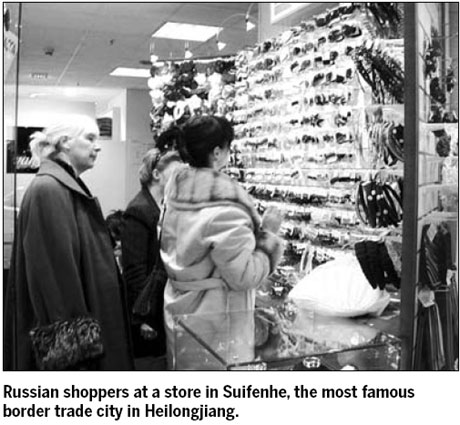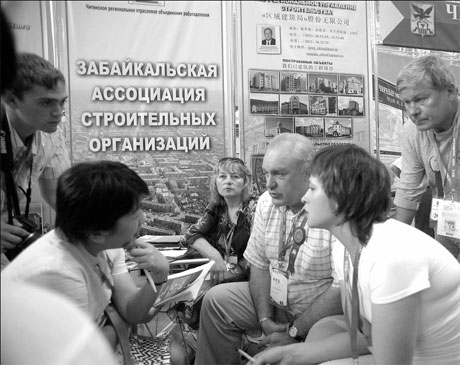New solutions needed to boost trade with Russia
|
Russian businesspeople seek trade opportunities at Harbin International Economic and Trade Fair. |
During the first quarter of this year, Heilongjiang's trade with Russia saw a year-on-year growth of 1.6 percent, representing a final turn around after a 14-month decline.
The province is the most important in China regarding trade with Russia, and its trade with the country accounts for a large proportion of its overall foreign trade.
However, due to the global financial crisis and Russia's fast-changing foreign trade policies, Heilongjiang's trade with Russia saw a drastic drop of 49.7 percent in 2009 compared with the previous year.
Statistics from the province's customs house show that Heilongjiang-Russia trade reached $1.4 billion in the first quarter. Imports from Russia jumped 95.8 percent year on year to $650 million, while exports still decreased 28.1 percent to $750 million. The export figures indicate that the province may have to wait longer to see a real recovery.
There is uncertainty as to whether growth can be sustained because trade with Russia still dropped 6.9 percent year on year in the first two months, in spite of the slight overall growth for the quarter.
The province had a better performance in its total foreign trade volume in the first three months, which increased 22.9 percent to reach $4.6 billion.
In particular, Heilongjiang's trade with its second largest partner, the United States, hit $440 million, growing 4.9 percent year on year. But trade with its third partner, the European Union, dropped 2.5 percent to $380 million.
New plans
How to revitalize the once-booming Heilongjiang-Russia trade is now a serious concern for authorities.
Seeing the plummeting Heilongjiang-Russia trade, the central committee of the Chinese Peasants' and Farmers' Democratic Party sent a special investigation team to the province.
After surveys and studies, the team members concluded that the outdated trade pattern, the lack of regional cooperation, in addition to the global financial crisis and Russia's changing trade policies, are the major reasons hindering further development of Heilongjiang's trade with the country.
The team noted that existing trade relies heavily on importing energy and raw materials from Russia. They suggested Heilongjiang should promote exports of its advantageous products, such as machinery and electronics, to Russia.
In addition, Heilongjiang should play a role as a bridge for the whole nation's trade with Russia, allowing more cutting-edge China-made products to be sold to Russia via the province.
The team also called for enhanced regional cooperation to boost trade. One of their suggestions is that the province should integrate its major export-oriented zones in Harbin, Daqing, Mudanjiang, Suifenhe and Dongning. They also advised Heilongjiang to closely coordinate with a UNDP-sponsored Tumen River Area Development Program in the bordering areas of Jilin, Russia and North Korea.
The team promised it would ask the central government to draft a long-term plan for business cooperation with Russia and other neighboring countries to eventually build a Northeast Asia free trade area.
Considering the rising trade protectionism in Russia, the team said implementing large-scale investment projects in both Heilongjiang and Russia might be a good solution for trade facilitation, because Sino-Russian joint projects will involve the interests of both sides.
Echoing the suggestions of the team, Yang Aiwu, a senior official with the Heilongjiang provincial government, said the government is considering new changes in Heilongjiang-Russia trade.
For example, he said, the emphasis should be shifted from trade cooperation to investment cooperation. And the forms of trade should be expanded from mere commodity trade to trade of technologies and services.
According to Yang, for the past several decades, Heilongjiang's trade with Russia has accounted for more than 20 percent of the total trade volume between China and Russia.
Cities in action
To boost trade with Russia, local governments in major trading cities such as Suifenhe and Daqing have taken concrete actions to adjust their trade-related strategies.
Suifenhe is one of the key border trade cities in Heilongjiang. It is now implementing a number of measures to facilitate trade.
The city is increasing investment to build such facilities as the bonded zone, the airport and several railways and highways.
The Suifenhe Bonded Zone is under construction and is expected to become a trial free trade area between China and Russia. Because a raft of preferential policies, provided by both China and Russia, are in place, the zone is set to attract many businesses from both countries to invest in manufacturing, processing and trade operations there.
With such plans, the city predicts its foreign trade volume will increase 15 percent this year from 2009.
In Daqing, the leading petroleum production area in China, the local government pins hopes on launching large investment projects, restructuring foreign trade enterprises and enhancing trade promotions.
At present, the city is engaged in building a number of energy cooperation projects. For example, it will be an important part of the Russia-China oil pipeline project.
With respect to restructuring its foreign trade enterprises, the government will encourage consolidations, mergers and acquisitions among the companies, aiming to forge a number of large enterprises with annual trade volume surpassing $50 million. In addition, it will also encourage private enterprises to be engaged in foreign trade businesses.
This year, the city will hold a number of trade fairs in major cities in Russia, to promote its advantageous products such as petrochemicals, textiles and petroleum machinery.
Authorities in Daqing expect the city's foreign trade volume to reach 1.09 billion yuan this year, an increase of 15 percent on last year.

(China Daily 05/14/2010 page17)









